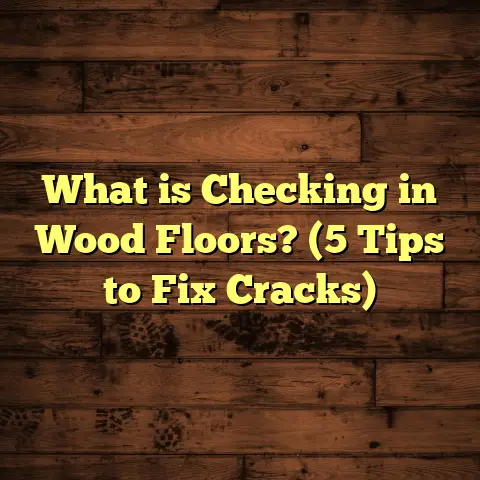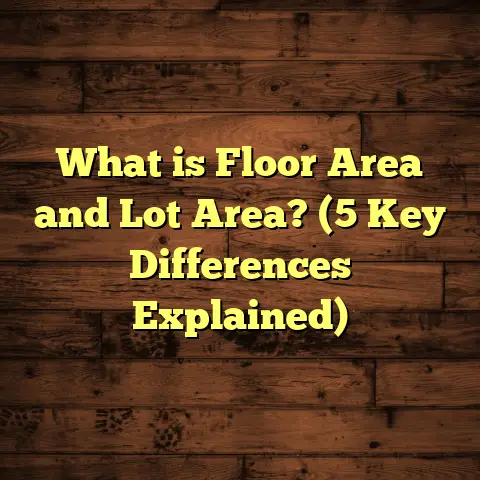What is Laminate Flooring vs Engineered Hardwood? (5 Key Differences!)
Changing your home’s flooring can feel like a big step, right? But sometimes, it’s exactly what a space needs to breathe new life. I’ve helped countless homeowners weigh their options between laminate flooring and engineered hardwood. Over time, I’ve noticed how the choice often boils down to lifestyle, budget, and how much effort you’re ready to put in for installation and maintenance.
Let me break down these two popular choices for you with some clear facts and stories from my own experience. Hopefully, by the end, you’ll have a solid idea of which fits your needs better.
What’s the Deal With Laminate Flooring?
Laminate flooring has been a favorite for many because it offers the look of wood without the high price tag. It’s made up of several layers:
- A wear layer on top for protection
- A design layer that simulates wood grain or other patterns
- A core layer made from high-density fiberboard (HDF)
- A backing layer to provide stability and moisture resistance
The planks usually come in standard sizes around 7 to 12 inches wide and 48 inches long. Thickness varies from about 6 mm to 12 mm, with thicker boards generally being more durable.
One thing I always mention is that laminate is a floating floor. That means it’s not nailed or glued down but clicked together over an underlayment. For many homeowners, this means installation can be done in a weekend—it took me about two days in a 300 square foot living room once, including prep work.
The upfront cost? On average, laminate flooring costs between $1.50 to $3 per square foot for materials. Add labor if you’re hiring a pro—that can run between $2 to $5 per square foot depending on your area. So, your total investment might hover around $1,000 to $2,400 for a 500 square foot room.
Here’s a quick story: I installed laminate in a client’s basement in Chicago last fall. The moisture barrier underneath was key because basements are prone to dampness. The laminate held up beautifully, and the clients loved how quickly and cleanly the project went.
Laminate’s Strengths
A big reason I often recommend laminate is its durability. The wear layer on top is tough—especially if you choose an AC3 or AC4 rated laminate. These ratings refer to abrasion resistance; AC4 can handle heavy residential and light commercial use, which means it stands up well even if you have pets or kids running around.
It’s also quite resistant to stains and fading from sunlight exposure, which is something hardwood floors sometimes struggle with.
What About Installation?
Because laminate is a floating floor, you don’t need nails or glue. The planks click-lock together with a tongue-and-groove system. This simplicity makes it a favorite for DIY projects. I’ve seen first-timers complete 300 sq ft rooms in just a weekend after watching some tutorials.
Underneath the laminate, you typically add an underlayment for cushioning and soundproofing. This can be foam or cork-based. In moist areas, a vapor barrier might be necessary to protect the floor from moisture coming up through the subfloor.
From my experience, prepping the subfloor is essential — it must be clean, dry, and level within 3/16 inch over 10 feet for laminate installation to go smoothly and avoid any issues later.
Maintenance Tips for Laminate
Laminate is pretty low maintenance. Regular sweeping or vacuuming keeps dust off the surface, and occasional damp mopping with water (not soaking wet) works well.
I once advised a client whose dog had scratched their hardwood floors badly but left their laminate flooring almost unmarked after a year of use. For families with pets or kids who tend to spill food or drinks, laminate can be forgiving.
However, laminate doesn’t handle standing water well — that can cause swelling or warping over time. So wiping spills promptly is key.
What Makes Engineered Hardwood Different?
Engineered hardwood looks and feels more like traditional hardwood because it actually has a veneer of real wood on top. The construction includes:
- A thin hardwood surface layer (usually 1–4 mm thick)
- Several layers of plywood or high-density fiberboard beneath it laid in alternating directions for strength
Sizes vary but typical planks are about 3 to 7 inches wide and 24 to 48 inches long. Thickness tends to range from 3/8 inch to 3/4 inch.
One big advantage is that engineered hardwood can be installed in places where solid hardwood isn’t recommended—like basements or over concrete slabs—because it’s more stable against moisture changes.
The price point reflects its quality: materials alone usually range from $4 to $10 per square foot. Labor runs higher too, often $3 to $8 per square foot because installation methods like glue-down or nail-down take more time and skill.
In one project in my own house (a 600 square foot kitchen renovation), I chose engineered hardwood because I wanted that authentic wood feel without the worry of warping near the sink area. It took me about four days working with a contractor to finish everything, including sanding and finishing the edges.
Why Choose Engineered Hardwood?
If you want that authentic wood grain texture and natural variation that comes with real wood, engineered hardwood delivers. The surface is real wood you can feel underfoot, unlike laminate’s plastic overlay.
It’s also stronger than solid hardwood when it comes to handling humidity changes because of the cross-layered plywood base. If your home has fluctuating moisture levels—like basements or kitchens—engineered hardwood makes sense.
Installation Considerations
Engineered hardwood installation is more varied than laminate:
- Nail-down: Popular on wooden subfloors
- Glue-down: Common over concrete slabs
- Floating: Some engineered hardwoods can click together like laminate
Because of these options and the need for precise fitting, professional installation is often recommended.
In terms of timeframes, expect an average of three to five days for a 500 sq ft room if you hire experts including prep work and finishing touches.
Caring for Engineered Hardwood
Engineered hardwood needs more care than laminate but less than solid hardwood. Avoid excessive water during cleaning — use wood floor cleaners designed for hardwood surfaces.
One homeowner I know refinished their engineered hardwood twice over ten years because the veneer thickness allowed sanding without compromising the floor’s integrity.
Five Key Differences Between Laminate and Engineered Hardwood
1. Material Composition & Visual Appeal
Laminate’s design layer is basically a photo under a hard plastic covering—so while it can mimic oak, maple, or bamboo looks with high accuracy, it lacks the depth and texture of real wood.
Engineered hardwood really has wood on top — so each plank carries unique grain patterns and natural imperfections that make your floor one-of-a-kind.
2. Durability & Longevity
Laminate often wins on scratch resistance due to its tough wear layer. Its plastic topcoat stands up well even in busy households with children or pets.
Engineered hardwood can be sanded — depending on veneer thickness — which lets you renew its surface as it ages. This gives it potential longevity beyond laminate, which cannot be sanded.
3. Installation Methods & Time
Laminate’s floating installation is simpler and faster — great for DIY enthusiasts or those who want minimal disruption.
Engineered hardwood may require glue-down or nail-down methods needing expert skills and longer installation times.
4. Price Differences
Laminate typically costs $1.50–$3 per sq ft material plus labor at $2–$5 per sq ft (installed total $3.50–$8).
Engineered hardwood materials range $4–$10 per sq ft with labor around $3–$8 per sq ft (installed total $7–$18).
If budget matters most, laminate generally fits better.
5. Maintenance & Repair
Laminate flooring is easy to clean but cannot be refinished if damaged — you replace entire planks instead.
Engineered hardwood requires more care but can be refinished once or twice over its life depending on veneer thickness.
Deep Dive Into Cost: What You Can Expect
When clients ask me about price, they want specifics — not just ranges. So let me share some numbers based on projects I’ve completed:
| Flooring Type | Material Cost per Sq Ft | Labor Cost per Sq Ft | Total Cost (Installed) | Installation Time (500 Sq Ft) |
|---|---|---|---|---|
| Laminate Flooring | $1.50 – $3 | $2 – $5 | $3.50 – $8 | 1-2 days |
| Engineered Hardwood | $4 – $10 | $3 – $8 | $7 – $18 | 3-5 days |
Here’s an example: I recently quoted a client in Seattle for installing laminate in their 600 sq ft living room with mid-range materials ($2/sq ft) plus labor at $3/sq ft. Total came out around $3,000 and took two days to install including prep.
For engineered hardwood in similar size rooms, especially if glue-down over concrete slab is needed (common in Seattle due to climate), costs rise quickly — materials at $7/sq ft plus labor at $5/sq ft pushing near $7,200 total with 4-day installation time.
Personal Experiences That Shaped My Advice
I remember helping a young couple renovating their first home on a tight budget who chose laminate flooring throughout their living area and bedrooms. They loved the quick install (done in just two days), the pet-friendly durability, and how modern laminate designs gave their home an updated feel without breaking the bank. They said it felt like a “fresh start” after years of old carpet and vinyl floors.
Contrast that with another family restoring a historic house who wanted authentic wood floors matching original oak planks upstairs. They opted for engineered hardwood with a thick oak veneer that could be sanded down if needed decades later. Though it cost more upfront ($15K for 900 sq ft), they felt this investment preserved the home’s character and boosted resale value significantly when they sold years later.
How Do Climate & Location Affect Your Choice?
If you live in areas with high humidity swings—like Florida or coastal regions—engineered hardwood holds up better as it resists warping from moisture changes thanks to its plywood core.
Laminate flooring can swell if moisture penetrates seams or underlayment if not properly installed with vapor barriers—something I always emphasize during consultations in humid climates.
In dry climates like Arizona or New Mexico, both options work well but engineered hardwood still looks more natural while laminate tends to keep its flat appearance consistently.
What About Environmental Impact?
If sustainability matters to you—both materials have pros and cons:
- Laminate uses fiberboard cores made from recycled wood fibers but contains plastic layers that aren’t biodegradable.
- Engineered hardwood uses less solid wood than traditional hardwood but still uses real wood veneers; some brands source wood from sustainably managed forests certified by FSC (Forest Stewardship Council).
During one eco-conscious project in Portland, I helped clients select FSC-certified engineered hardwood paired with low-VOC finishes for healthier indoor air quality—a growing priority among homeowners today.
How Flooring Influences Home Value
I often get asked: “Will laminate hurt my home resale?” The answer depends on market expectations where you live.
Data from real estate agents I work with shows:
- Homes with genuine hardwood floors (solid or engineered) tend to sell faster and at higher prices.
- Laminate flooring doesn’t add much value but won’t necessarily deter buyers if it looks good and is well-maintained.
- High-end laminate mimicking exotic woods can impress buyers but rarely compares fully to real wood floors in appraisal value.
In a recent case study of homes sold in Dallas area:
- Properties with engineered hardwood floors sold on average for 5% more than those with laminate.
- Homes with laminate floors still sold within average market times if other features were strong.
Can You Mix Both Flooring Types?
Absolutely! Some clients use engineered hardwood in main living areas where they want luxury feel then switch to laminate in basements or kids’ rooms where durability matters more than appearance.
I recently completed such a project where:
- Engineered hardwood covered 800 sq ft of living room/dining/kitchen
- Durable AC4-rated laminate covered 400 sq ft basement playroom
This approach balanced budget and style nicely while addressing different rooms’ functional needs.
Exploring New Trends
Both laminate and engineered hardwood have evolved recently:
- Laminate: Now offers wider planks (up to 12”) with textured finishes mimicking hand-scraped or distressed woods.
- Engineered Hardwood: Newer finishes include wire-brushed surfaces and matte coatings that reduce glare while enhancing natural grain textures.
I find clients often surprised by how close laminate looks now compared to expensive hardwoods just five years ago.
Quick Recap & Tips Before You Decide
Before making your choice:
- How much time are you willing to spend on installation?
- What’s your budget range?
- Do you have pets or kids who might test durability?
- Are you planning to stay long-term or sell soon?
- Is authentic wood important for your style?
Answering these will help guide you toward the right fit.
If you want detailed cost estimates based on your local market, I suggest trying tools like FloorTally — they factor in material prices, labor rates, waste allowances, and can save you from surprises during budgeting.
Final Thoughts From My Years Working With Floors
I get asked all the time: “Which one should I pick?” Honestly? It depends on your priorities—and there’s no wrong answer if you choose thoughtfully.
Laminate offers affordability, quick installation, and great durability at lower cost — perfect for busy families and renters who want good looks without fuss.
Engineered hardwood offers authentic beauty, longer lifespan through refinishing options, and works well where moisture might be an issue — ideal for homeowners who want long-term investment in style and value.
Whatever you decide, knowing these differences helps avoid buyer’s remorse down the road—and makes sure your floors keep looking great for years to come.
Feel free to reach out if you want help figuring out what suits your home best—I’m happy to share more personalized advice!





